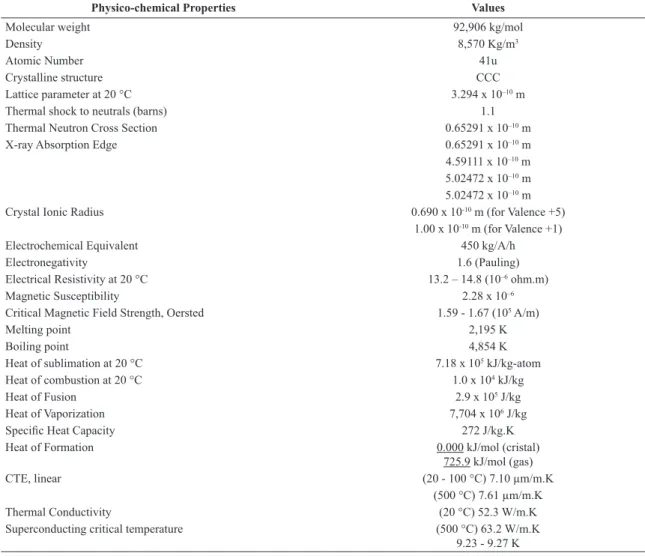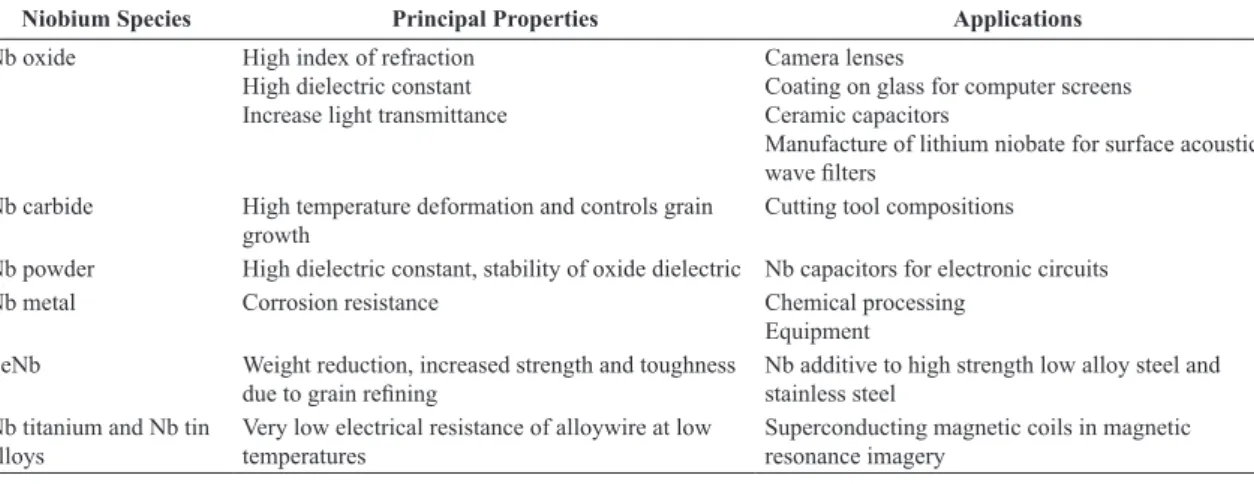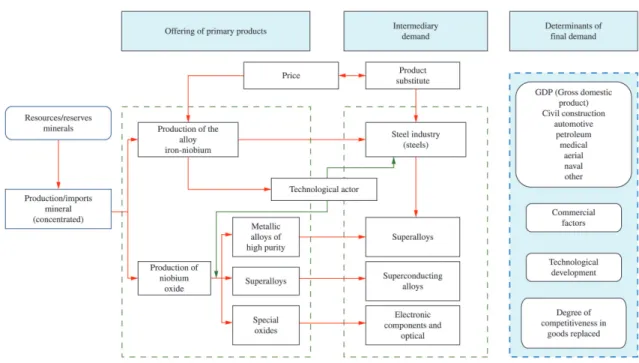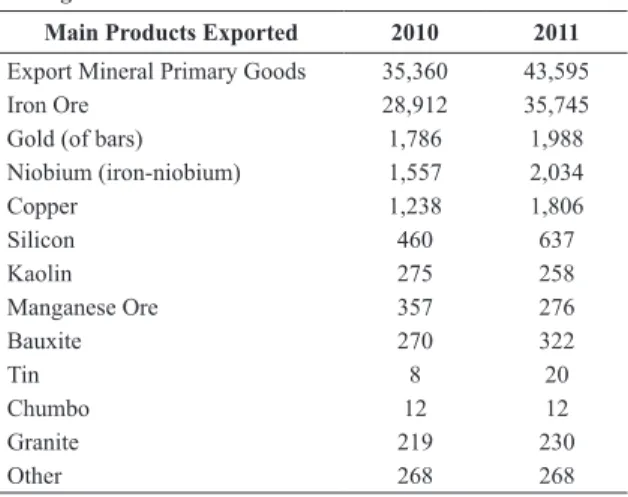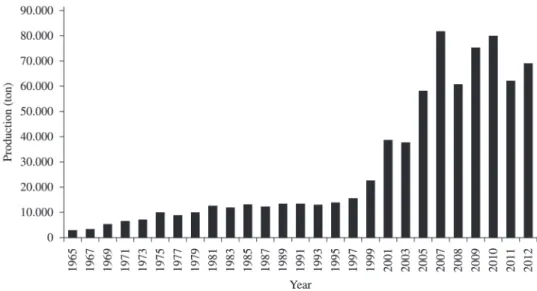*e-mail: arcoutin@unimep.br
1. Historical Aspects
The presence of niobium in nature is associated with pegmatite in the form of columbite, tantalite, or the alkali carbonatites mass, constituting the termed mineral pyrochlore1.
In the year 1801, the English chemist Charles Hatchett (1765-1847) discovered a new chemical element of atomic number 41. Initially it was called columbium, being the name given in honor of America, whence arose the mineral1-2. In 1802, the chemist Anders Gustaf Ekeberg (1767-1813) reported his indings to the French journal Annales de Chemie, the identification of a new element, which was named tantalum. In 1809, William Hyde Wollaston (1766-1828), responsible for the elements discovering rhodium and palladium announced that colombium and tantalum were identical1-3.
Years later, Heinrich Rose (1795-1864), noted the presence of two distinct elements in columbite, tantalum discovered by Ekeberg and others who called niobium, which corresponds in Greek mythology the daughter of tantalum, but it was actually the columbium discovered by Hatchett4.
In 1950, 149 years after the discovery of Hatchett, the International Union of Pure and Applied Chemistry (IUPAC) adopted Niobium as the oficial name. However, columbium name has been accepted for a long time by metallurgical and chemical industry in the U.S., so that name is still in use1-5.
1.1. The main properties of niobium
Niobium belongs to the group of metals having a high melting point, is corrosion resistant, has good ductility at room temperature, consists of gray color, and acquires blue color when exposed to air for a long period6-7.
The niobium is resistant to corrosion due to the formation of an oxide ilm on its surface, when combined have multiple oxidation states, in which the +5 is the most common state. In ambient temperature conditions, does not react with hydrogen, air, water, or acids, except hydroluoric acid and its mixture with nitric acid. On the other hand, under the effect of the temperature increase Nb reacts with most non-metallic and generates products that are non-stoichiometric and interstitial elements. Under these conditions, it is also resistant to attack by molten bases6-7.
Nb is characterized by having only one stable isotope, which has the crystalline structure in the form of body-centered cubic (CCC). The physical and mechanical properties of the Nb are inluenced by the purity of the metal, so even small quantities of interstitial impurities may promote degradation of the properties of the metal. The main impurities of Nb products in accordance with speciications of the American Society for Testing and Materials (ASTM), are oxygen, nitrogen, hydrogen, carbon, iron, molybdenum and tungsten7-8.
The physico-chemical properties of niobium are similar to tantalum, implying an occurrence together in nature, so that it becomes dificult their separation. One of the methods consists in the hydrometallurgy process known by use of methyl isobutyl ketone, under acidic conditions. This procedure allows the isolation of niobium pentoxide (Nb2O5) which can be reduced from use of aluminum, known as aluminothermic process which generates niobium and aluminum oxide7-8.
The tables that follow show the main properties of niobium9-11: physic-chemical (Table 1) and mechanical (Table 2).
The Evolution of the Niobium Production in Brazil
Adilson Rangel Alvesa,b, Aparecido dos Reis Coutinhoa*
aUniversidade Metodista de Piracicaba – UNIMEP, SP 306, Km 01, CEP 13450-971,
Santa Barbara d’Oeste, SP, Brasil
bCentro Federal de Educação Tecnológica de Minas Gerais – CEFET-MG, Campus IV,
Av. Ministro Olavo Drummond, 25, CEP 38180-510, Araxá, MG, Brasil
Received: February 25, 2014; Revised: January 7, 2015
Niobium (Nb) was initially applied in the industry in 1933 to stabilize stainless steels against intergranular corrosion. Around 1970, niobium started to be used in many technological applications, especially in heat treatments at high temperatures, in the form of superalloys and, over the past four decades, Nb has been employed on an industrial scale. During recent years, applications of niobium have increased steadily in various segments such as: micro-alloyed steels, super alloys, thin ilms, medical implants, titanium and aluminum alloys, superconductors and copper alloys, electrolytic and ceramic capacitors. The worldwide demand for Nb grew at an annual rate of 10% between the years 2000-2010, were the sectors of energy, automotive and construction of the largest consumers FeNb. In 2000 the brazilian production was 35,458 t of Nb and, in 2007, reached 82,000 t of concentrate Nb. Brazil has the world’s largest reserves of Nb (98.53%), which totaled 842.4 million t. So, in this paper is made a study on the evolution of the production of niobium in Brazil and its main industrial and technological applications.
It is observed in Table 1 high values of melting point, exceeding many ferrous and nonferrous metals. Its high melting point permits its use as a component of various alloys9-11.
With only 8.57 grams per cubic centimeter, the density of niobium is only about half that of tantalum, one of the lightest of refractory metals. Also, it has a higher strength-to-weight ratio compared to metals titanium, nickel, vanadium and zirconium. This is an important industrial, where weight is an important factor in the industrial use of the property Nb7-11.
The Nb presents high and higher values for the mechanical properties compared to ferrous metals in general, such as tensile strength and modulus of elasticity. Also, there is very low electrical resistivity of Nb, compatible to other refractory metals. Moreover, its thermal conductivity increases directly with the increase in temperature, as well as most metals9-11.
1.2. The main applications of niobium
Niobium was irst applied as a material in the industry in 1933 to stabilize stainless steels against intergranular corrosion. In early 1960s, researches showed that niobium contains microalloying properties that promote signiicant improvements in resistance of steels. Later, around 1970, Nb began to be used in several advanced applications, especially in heat at high temperatures, in the form of superalloys, and in the last four decades Nb has been employed in industrial scale12-14.
Most of the production of Nb is its processing as FeNb, for direct use in the steel industry. Moreover, the Nb is employed in the design and production of special alloys, especially used in the manufacture of high-strength steels Table 1. Physico-chemical properties of the niobium9-11.
Physico-chemical Properties Values
Molecular weight 92,906 kg/mol
Density 8,570 Kg/m3
Atomic Number 41u
Crystalline structure CCC
Lattice parameter at 20 °C 3.294 x 10–10 m
Thermal shock to neutrals (barns) 1.1
Thermal Neutron Cross Section 0.65291 x 10–10 m
X-ray Absorption Edge 0.65291 x 10–10 m
4.59111 x 10–10 m
5.02472 x 10–10 m
5.02472 x 10–10 m
Crystal Ionic Radius 0.690 x 10-10 m (for Valence +5)
1.00 x 10-10 m (for Valence +1)
Electrochemical Equivalent 450 kg/A/h
Electronegativity 1.6 (Pauling)
Electrical Resistivity at 20 °C 13.2 – 14.8 (10–6 ohm.m)
Magnetic Susceptibility 2.28 x 10–6
Critical Magnetic Field Strength, Oersted 1.59 - 1.67 (105 A/m)
Melting point 2,195 K
Boiling point 4,854 K
Heat of sublimation at 20 °C 7.18 x 105 kJ/kg-atom
Heat of combustion at 20 °C 1.0 x 104 kJ/kg
Heat of Fusion 2.9 x 105 J/kg
Heat of Vaporization 7,704 x 106 J/kg
Speciic Heat Capacity 272 J/kg.K
Heat of Formation 0.000 kJ/mol (cristal)
725.9 kJ/mol (gas)
CTE, linear (20 - 100 °C) 7.10 µm/m.K
(500 °C) 7.61 µm/m.K
Thermal Conductivity (20 °C) 52.3 W/m.K
Superconducting critical temperature (500 °C) 63.2 W/m.K 9.23 - 9.27 K
Table 2. Mechanical properties of the niobium9-11.
Mechanical Properties Values
Hardness, Vickers 80
Tensile Strength, Ultimate 300 MPa Tensile Strength, Yield 207 MPa
Elongation at Break 30%
Modulus of Elasticity 103 GPa
Poissons Ratio 0.38
for the automotive, marine (offshore platforms, pipelines) and civil construction (bridges and buildings). In addition, Nb is used in the production of superalloys which are used at high temperatures, for example in the aerospace use that are present in the manufacture of turbine components6,12-17.
During recent years, applications of Nb have increased steadily in various segments such as: microalloyed steels, super alloys, thin ilms, medical implants, titanium and aluminum alloys, copper alloys and superconductors, ceramic capacitors and electrolytic, and others6,12-17.
In the construction industry Nb plays an important role in the development of more resistant steels, which can contribute to reduction of total project costs of infrastructure, even as they become increasingly complex. On the other hand, the demand of the construction industry will continue to be increasingly growing due to urbanization, population growth and replacement of infrastructure very old, so the need for lighter structures result in greater use of high quality steel containing Nb6,12-17.
In the automotive industry, increased employment of Nb led to a series of innovations in the manufacturing of parts requiring several types of steels, for example, steels with high strength low alloy, called HSLA. The manufacture of parts from use of HSLA steels help to reduce fuel consumption, reduce CO2 emissions and increase passenger safety. Therefore, in view the increased production of cars worldwide, the demand for Nb in the automotive industry is expected to grow signiicantly in the coming years6,12-17.
In the energy sector there forecasting strong growth in production and consumption natural gas (NG) by the year 2035. For example, an increase around 20% in OECD countries (The Organisation for Economic Co-operation and Development) and up to 68% in non-OECD countries, according to information from the EIA (US Energy Information Administration). Consequently, the increase in production of Nb will be directly linked to the growth in demand for HSLA steel, depending on the need of transporting over long distances, high pressure, requiring steel tubes with increased mechanical strength and with this will increase the participation the niobium in energy production12-17.
In the petroleum industry, the use of HSLA is higher, so that the increase in offshore drilling platforms entails the
need for more stringent performance of the steels according to the harshest conditions in increasingly deep wells. Thus, in this segment the presence of niobium is essential in improve the properties of steels used in pipes, ittings and equipment for drilling in general12-17.
In the medical ield, the use of niobium is growing and evolving, for example, is used in magnetic resonance imaging (MR), which is a diagnostic tool, whose use has increased significantly over the past three decades. In addition, another use is as an element of orthopedic implants by the addition of other bio compatibles metals18-19.
In the field of electronics and nanotechnology, niobium and tantalum in powders are used in industry as nanostructured materials, due to its characteristic of high purity, as small amounts of contaminants oxygen and metals low density18-19.
The trend in computing for the next decade is the possibility of the development of quantum computer. Quantum computing, such as atoms and molecules, does not follow the laws of physics and can process multiple data simultaneously, with unlimited capacity, and this is possible with the application of nanotechnology. So, the use of Nb contributes to this industrial segment. For example, in 2007, the Canadian D-Wave showed the Orion computer based on a silicon chip, which is formed by portion of niobium, surrounded by a coil. When the coil is electrically stimulated, it generates a magnetic ield that causes changes in the state of Nb atoms. These state changes are captured and processed by the circuits and transformed into data. For all this to work, the quantum chip needs to be frozen to four milikelvins (mK). This is done by means of a cooling system with liquid helium and becomes low temperature superconducting Nb12-20.
So, from the considerations and examples, Table 3 summarizes the main applications of niobium in various industry segments, and science and technology12-20.
In this scenario technological applications ranging from civil construction, shipbuilding, aerospace, energy, electronics, medical and other segments require a signiicant increase in niobium consumption, due to new projects that require lighter more resistant steels, lighter special alloys or byproducts of to meet increased demand of technical standards and innovative technology.
Table 3. Some types of products Nb and applications12-20.
Niobium Species Principal Properties Applications
Nb oxide High index of refraction High dielectric constant Increase light transmittance
Camera lenses
Coating on glass for computer screens Ceramic capacitors
Manufacture of lithium niobate for surface acoustic wave ilters
Nb carbide High temperature deformation and controls grain growth
Cutting tool compositions
Nb powder High dielectric constant, stability of oxide dielectric Nb capacitors for electronic circuits Nb metal Corrosion resistance Chemical processing
Equipment FeNb Weight reduction, increased strength and toughness
due to grain reining Nb additive to high strength low alloy steel and stainless steel Nb titanium and Nb tin
alloys
Very low electrical resistance of alloywire at low temperatures
1.3. The demand for niobium
As of 2010, the largest consumers of Nb are China, followed by North America and Europe. China is the strongest growth market in world of Nb consumption, accounting for 25% of total consumption, which relects the size and importance of its steel industry. For example, China is the largest producer of stainless steel, and in the 1990s had an increase in their share in world production between 1-2% to 36.7% in 201014-15,17,20.
The growth of steel production is not the only factor in sales increase of Nb, so that another important factor that should be taken into account is the increase in the speciic consumption of iron-niobium. For example, China showed an increase in speciic consumption of FeNb of 11 g/t in 2004 to 35 g/t in 2008, while Brazil showed speciic consumption of 100 g/t of FeNb in 200814-15,17,20.
The high rate of growth of the BRIC countries, GPD has directly resulted in increased demand for steel production. For example, world grew 5.1% in 2010, which played an important role in the economies of the BRIC countries, which grew 8.8%, which represents more than a third of world GPD growth. The forecast for 2020 is that the BRICs countries should contribute about 49.0% of overall growth, taking into account the growth of steel production and the direct increase in demand for Nb14-15,17,20.
Thus, in this scenario, the global demand for Nb grew at an annual rate of 10% between the years 2000-2010. Growth was driven by strong demand for steel, especially among the BRIC countries, which in 2010 produced around 1,4.106 t, representing an increase of about 14%, where the sectors of energy, automotive and construction industries showed largest consumers of FeNb14-15,17,20.
Figure 1 shows a simplified diagram of the main applications of Nb and its speciic demand in the industrial and technological sector21-23.
The diagram shows the interrelationship of the various stages of production and consumption of Nb by means a direct connection between supply and demand of the product, which can divide the market for Nb in 3 phases: a) providing primary products; b) intermediate demand; c) the inal demand. It is suggested that the market demand is divided into two types of products: alloy iron-niobium and niobium oxide alloy. The second type (niobium oxide) is related to the production of more sophisticated and high technology materials. The maximum production of one or another type of alloy is related to the technological factor, which is a guide for industrial production21-23.
The technological factor is directly linked to final demand, which determines the direction of the primary product. Final demand also demonstrates the level of technological development of the country, when the demand for more sophisticated products supplants the need for primary products, keeping in mind that the high-tech sectors such as medical, marine, aerospace, among others, seek to niobium in special alloys, high purity or superalloys21-23.
The growth in demand for raw materials called rare earths is in evidence, as well as its importance as a strategic material. According to Moss23, 14 metals that may be needed in signiicant amounts to the deployment of low-carbon steel, directed the productions of special alloys technologies were identiied. For example, metals such as niobium, selenium, tin and vanadium, must show increase in their demand, requiring 1% or more of world supply per year in the period between 2020 and 2030. Niobium in turn has a signiicant demand, primarily for the use in steel used in oil pipelines, as well as in the aerospace and building industries21-23.
Projections for niobium consumption was restricted to the main product, the alloy iron-niobium. The methodology used for the projections via explanatory model of consumption function, showed a demand of iron-niobium alloy in the order of 85,000 t for 2010 and 188,000 t in 2030, which correspond to 140 thousand t and 308,000 t respectively production of ore concentrated niobium, required to meet the anticipated demand for these years. The most signiicant increase niobium is yet to come, especially given the concern with sustainability. Iron-niobium can, for example, help produce lighter cars which consume less fuel24-26.
1.4. Production of niobium
Brazil is one of the largest producers and exporters of minerals in the world. Table 4 shows the economic data exports of the main products of the mining sector, and the
iron ore occupied the 1st place and that niobium reached gold, the list of brazilian exports24-26.
Figure 2 shows the evolution of brazilian export of FeNb between the years 2000 and 2011, were initially observed the increasing exports the order of 28,000 t in 2000 to about 73,000 t in 2008. In 2009 there was a sharp drop in export of FeNb, to 45,000 t due to the global economic downturn, between 2008 to 2009. It is observed, however, the recovery in exports in the years 2010 and 2012, reaching a level of 70,000 t again24-26.
Brazil has the world’s largest reserves of Nb (98.53%), followed by Canada (1.01%) and Australia (0.46%). Reservations measures brazilian niobium (Nb2O5) totaled 842.4 million tons, with an average grade of 0.73% Nb2O5 and are concentrated in the states of Minas Gerais (75.08%), in Araxa and Tapira; Amazonas (21.34%), in São Gabriel da Cachoeira and Presidente Figueiredo and Goiás (3.58%), and in Catalão with an average grade of 0.73% Nb2O5[24-26].
In addition, Table 5 shows that Brazil stand out with 98.53% of the world Nb mineable reserves, and is the largest producer of the metal, representing approximately 97.2% of the global total. In this scenario, the State of Minas Gerais (MG) is the largest producer, with a share of 83.6%, followed by the State of Goiás (GO) with 15.3% and the State of Amazonas (AM) with 1.1%24-28.
Figure 3 shows the evolution of FeNb production in Brazil from 1965 to 2012. In the period 1965 to 1995 the production increased by about 5 times, and the 10-year period 1995-2005, the increase was about 4.5 times, the last 5 years, between the years 2005 - 2010, the increase in the production of niobium was 1.3 times24-28.
In 2000, Brazilian production was 35,458 t of FeNb and, in 2007, reached 82,000 t of concentrate FeNb. This growth was due to the demand of FeNb due to the increase in steel production that accompanied economic growth in developing countries, especially China. In the Brazil two companies complete the cycle of the production of ore Table 4. Main minerals exported24-26.
Foreign trade of the mineral sector amounts in millions of US$
Main Products Exported 2010 2011
Export Mineral Primary Goods 35,360 43,595
Iron Ore 28,912 35,745
Gold (of bars) 1,786 1,988
Niobium (iron-niobium) 1,557 2,034
Copper 1,238 1,806
Silicon 460 637
Kaolin 275 258
Manganese Ore 357 276
Bauxite 270 322
Tin 8 20
Chumbo 12 12
Granite 219 230
Other 268 268
and the niobium alloys, which are CBMM (Companhia Brasileira de Metalurgia e Mineração) in Araxá, Minas Gerais and Goiás Mining in Catalão27-28.
CBMM holds reserves estimated in 400 years with durability, predicts 60% growth in sales of FeNb until 2015, with capacity to produce 90,000 t of FeNb per year with goal of achieving production of 150 000 t in 201327.
Another company, Anglo American Brazil, began operations in the city of Catalão (GO), in order to recover the Nb contained in the tailings and waste lotation of phosphate mining operations in the region. The material with an average grade of 0.5% Nb2O5 feeds a concentration plant with capacity to produce 5,000 t/y of niobium concentrate with 48% of Nb2O5[28].
Finely, Brazil accounts for almost the entire supply of the alloy iron-niobium metal and other compounds. Brazilian companies have a installed capacities for mining and metallurgy suficient for the attendance current levels
of world demand, using modern technologies for mining, concentration and metallurgy and make significant investments in the expansion and modernization of production facilities metallurgy, as well as in research and development of new products made from niobium, encouraging diversiication and increased use of niobium in the steel and metallurgical products24-28.
2. Conclusions
Brazil is the largest producer of almost all niobium consumption worldwide. In contrast, exports of iron-niobium contribute to the surplus in the balance and this metal is now the third most important item on the agenda of mineral exports.
The scenario of increasing global demand for niobium in recent years at a rate of 10% per year puts the ore in a prominent position, since the greatest consumption occurred from 2004, primarily driven by increased production and consumption of steel in the world.
New applications for the ore are welcome and every effort should be made. However, to further develop technology, it becomes necessary to develop new materials and thereby increase the demand for the metal.
Thus, strategies that promote the Brazil´s natural heritage could be further encouraged by the government to do more to harness the national well that the historical market insertion and openness to foreign capital, can give the real importance that your product has to the world market. Figure 3. Historical of the production of niobium in Brazil24-26.
Table 5. Profile of the mineable reserves of niobium by countries24-26.
Countries Reserves (103 t)
Brazil 4,133
Canadá 61
Others Countries 21
Total 4,215
References
1. Griffith WP and Morris PJT. Charles Hatchett FRS (1765-1847), chemist and discoverer of niobium. Notes & Records
of the Royal Society. 2003; 57(3):299-316. http://dx.doi.
org/10.1098/rsnr.2003.0216.
2. Greenwood NN. Vanadium to dubnium: from confusion through clarity to complexity. Catalysis Today. 2003; 78(1-4):5-11. http://dx.doi.org/10.1016/S0920-5861(02)00318-8.
3. Silva PP and Guerra W. Platina. Química Nova na Escola.
2010; 32:128-129.
4. Steed J. Chemistry in its element: niobium. London: Royal Society of Chemistry; 2013. Available from: <http://www. rsc.org/chemistryworld/podcast/interactive_periodic_table_ transcripts/niobium.asp>.
5. Sousa RMF, Fernandes LE and Guerra W. Nióbio. Química
6. Grill R and Gnadenberger A. Niobium as mint metal: production: properties: processing. International Journal of
Refractory Metals & Hard Materials. 2006; 24(4):275-282.
http://dx.doi.org/10.1016/j.ijrmhm.2005.10.008.
7. Grill R. Niobium for coins. TIC Tantalum: Niobium.
International Study Center-Bulletin. 2007; 129:6-8.
8. Ayanda OS and Adekola FA. A review of niobium-tantalum separation in Hydrometallurgy. Journal of Minerals & Materials Characterization & Engineering. 2011; 10:245-256. 9. ASM International. Properties and selection of the metals. 8th
ed. Ohio; 1961. ASM Handbook 1.
10. ASM International. Properties and selection: nonferrous alloys
and special-purpose materials. 10th ed. Ohio; 1990. ASM
Handbook 2.
11. Kepert DL. The early transition metals. London: Academic Press; 1972. 142 p.
12. Rowe CED. Tantalum and Niobium in chemical applications.
Tantalum-Niobium International Study Center Bulletin. 1999;
97:2-5.
13. Graham RA, Sutherlin RC and Wah C. Niobium and Niobium alloys in corrosive applications. In: Niobium Science and Technology; 2001. Florida: TMS; 2001. p. 337-355. 14. Oliveira M, Jansto S, Mohrbacher H, Patel J and Stuart M. 30
Years of Niobium steel development in China. 2013. Available
from: <http://www.metal.citic.com/iwcm/UserFiles/img/ zlk/03_30zn/d7.pdf>.
15. Aggarwal G, Park SJ and Smid I. Development of niobium powder injection molding. Part I: feedstock and injection molding. International Journal of Refractory Metals & Hard
Materials. 2006; 24(3):253-262. http://dx.doi.org/10.1016/j.
ijrmhm.2005.06.003.
16. Tither G. Progress in Niobium markets and technology 1981-2001. In: Proceedings of the International Symposium Niobium; 2001. Orlando, Florida. Available from: <http://www.cbmm. com.br/portug/sources/techlib/science_techno/table_content/ images/pdfs/oppening.pdf>.
17. IAMGOLD. Niobium 101. 2012. Available from: <www. iamgold.com/English/Operations/Operating-Mines/Niobec-Niobium-Mine/Niobium-101/default.aspx>.
18. Alberich Bayarri A, Martí Bonmatí L, Lafuente J, Guibelalde del Castillo E, Escuela Superior de Resonancia Magnética
Clínica and Asociación para el Desarrollo y la Investigación en Resonancia Magnética. Utilización segura de la resonancia magnética. Recomendaciones prácticas para el personal que trabaja con resonancia magnética. Radiología. 2013; 55(2):99-106. http://dx.doi.org/10.1016/j.rx.2012.10.005. PMid:23332580
19. Grabis J, Munter R, Blagoveshchenskiy Y, Gorkunov V and Yamshchikov L. Plasmochemical Process for the Production of Niobium and Tantalum Nanopowders. Proceedings of the
Estonian Academy of Sciences. 2012; 61(2):137-145. http://
dx.doi.org/10.3176/proc.2012.2.06.
20. Oliveira M, Jansto S, Mohrbacher H, Patel J and Stuart M. China technology development Nb-steel. In: 30th Anniversary International Symposium; 2013. Available from: <http://www. metal.citic.com/iwcm/UserFiles/img/zlk/03_30zn/d7.pdf>. 21. Herbst L. A solution and solid state study of niobium complexes.
[Dissertation of Magister Scientiae]. South Africa: Faculty of Natural and Agricultural Sciences, University of the Free State; 2012.
22. Silva LGO. Nióbio: mercado nacional e internacional, modelo
de previsão do consumo de ferro-nióbio. [Dissertação].
Campinas: UNICAMP; 1994. 117 p.
23. Moss RL, Tzimas E, Kara H, Willis P and Kooroshy J. The potential risks from metals bottlenecks to the deployment of strategic energy technologies. Energy Policy. 2013; 55:556-564. http://dx.doi.org/10.1016/j.enpol.2012.12.053. 24. Brasil. Ministério de Minas e Energia. Departamento Nacional
de Produção Mineral – DNPM. Sumário Mineral. Brasília; 2012. 136 p.
25. Departamento Nacional de Produção Mineral – DNPM. Brasília; 2009. Available from: <https://sistemas.dnpm.gov. br/publicacao/mostra_imagem.asp?IDBancoArquivoArqui vo=5481>.
26. Instituto Brasileiro de Mineração – IBRAM. Informações e análises da economia mineral brasileira. 7. ed. Belo Horizonte; 2012.
27. Companhia Brasileira de Metalurgia e Mineração – CBMM. 2013. Available from: <http://www.cbmm.com.br/br/p/108/ home.aspx>.
